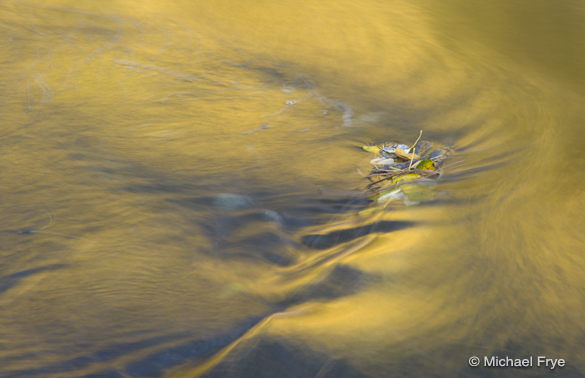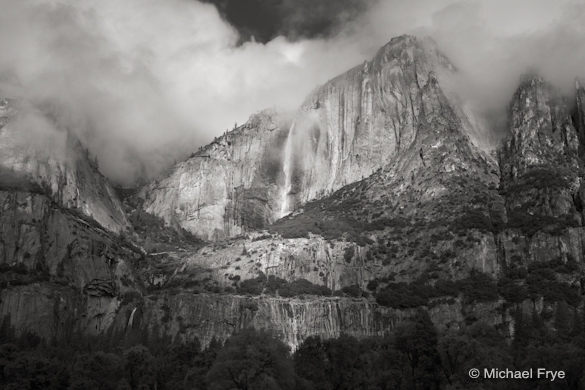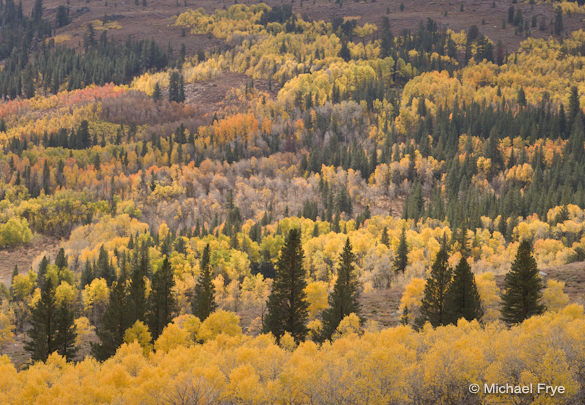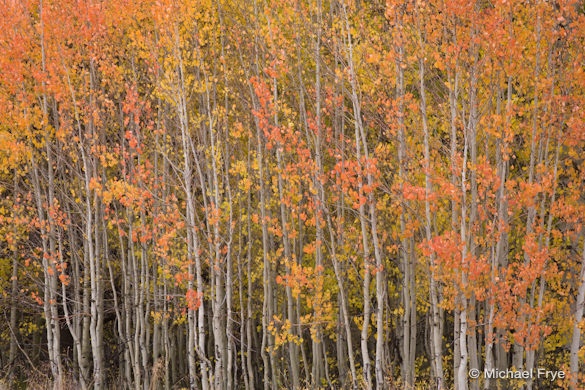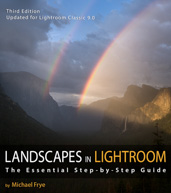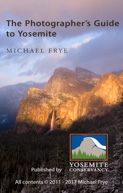Yosemite Photo Conditions
by Michael Frye | Nov 8, 2010 | Yosemite Photo Conditions
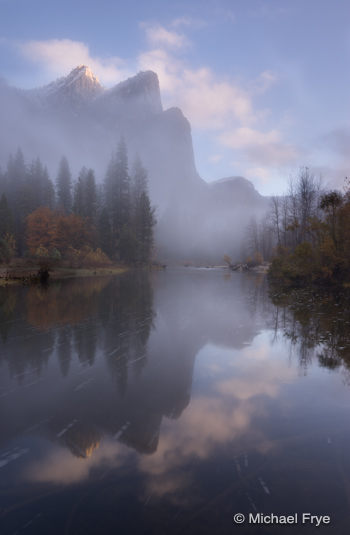
What a magical day it was in Yosemite Valley. The storm cleared overnight, and Claudia and I rose early to make the drive to the park. We saw a misty sunrise, a dramatic sunset, and beautiful fall color. Everywhere I looked there was another photograph, and another, and another—all demanding to be captured. I did my best to oblige. Here’s a morning view of Three Brothers in the mist; I’ll post more images soon.
Although some leaves were knocked down by the storm, most survived, and it looks like we’ll still have plenty of autumn color through this weekend.
First light on Three Brothers, around 7:00 a.m. this morning
by Michael Frye | Nov 7, 2010 | Yosemite Photo Conditions
Cottonwood leaves and reflections in the Merced River, Yosemite
What a difference a week makes. Last Sunday, October 31st, the color in Yosemite Valley was progressing, but still not there yet. Yesterday I returned to the valley for a private workshop and found colorful leaves everywhere. All the deciduous trees—maples, dogwoods, cottonwoods, and oaks—are turning. Green leaves, abundant a week ago, are now in a small minority. All four species of deciduous trees are close to, or at, their peak autumn color.
Most years the maples and dogwoods turn before the oaks and cottonwoods, so the color is spread out over several weeks. It’s unusual for all these trees to be near peak at the same time, and I’ve seldom seen the valley look more beautiful than it did yesterday. I don’t know how long this will last. A significant storm arrived today, and forecasters are predicting one to two feet of snow above 6000 feet. While it probably won’t snow in Yosemite Valley, at 4000 feet, the rain will knock down some leaves—although surely not all of them. I’m planning to go up to the valley again tomorrow when the storm clears, so I’ll let you know what I find.
This storm has closed Tioga Pass. The pass closes for the winter after the first significant snowfall in November, so it will probably remain closed until spring. My favorite eastern Sierra locations, only a few hours away during the last five months, now require seven hours of driving to reach! I’ve always wanted to visit Mono Lake in winter, so maybe this will be the year, but if not then I’ll return when the pass reopens in May or June.
My five-day workshop, The Digital Landscape: Autumn in Yosemite, finished last week. While the autumn color had not yet reached its peak, we still found many colorful leaves to photograph, and saw some fantastic light and weather, as you can see from this view of Yosemite Falls as a storm was clearing. The group was diverse and interesting, with participants from Sweden, Belgium, New York, Texas, and Minnesota. I think this is the first time I’ve ever taught a Yosemite workshop with no California students! Anyway, thanks to everyone in the group for making this a fun class.
Clearing Storm Over Yosemite Falls
by Michael Frye | Oct 27, 2010 | Yosemite Photo Conditions
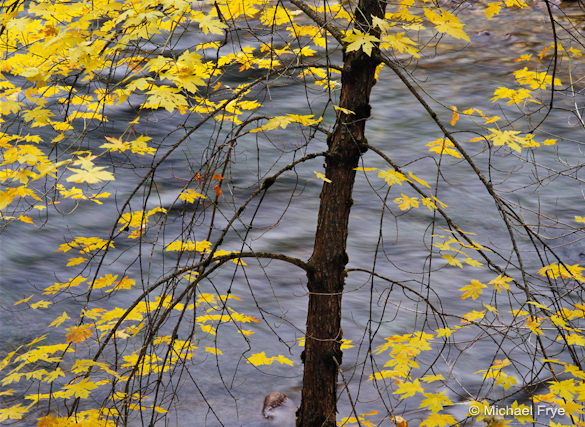
Big-leaf maple… from a few years ago
Fall Color in Yosemite Valley is late—really late. I reported last week that about 50 percent of the maple leaves had turned, 20 percent of the cottonwoods, 20 percent of the dogwoods, and 5 percent of the oaks. Well it’s nearly a week later and I’d say the percentages are the same! Hardly anything has changed. There is some good color in spots: as before, the best places are around Pohono Bridge and underneath Cathedral Rocks along Southside Drive. I heard a reliable report that the dogwoods along Highway 120 are about half turned.
At this point don’t want to even try to predict when the color will peak, or what kind of autumn it might be, as this season is progressing more slowly than any fall I can remember. I’ll let you know if things suddenly start to turn.
by Michael Frye | Oct 21, 2010 | Yosemite Photo Conditions
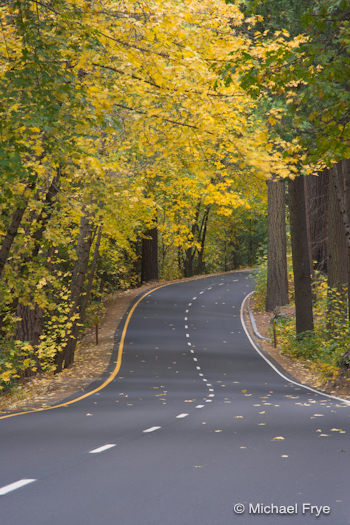
I spent the last two days in Yosemite Valley doing a private workshop. The weather was fantastic—we got to photograph lots of interesting clouds and chiaroscuro light patterns. More potentially photogenic stormy conditions are predicted through the weekend.
The autumn color in the valley is improving every day, but it’s still not quite there yet. There are four main types of deciduous trees in the valley: big-leaf maples, dogwoods, cottonwoods, and black oaks. The maples usually change color first, and this year is no exception. You can find nice displays already near Pohono Bridge and along Southside Drive underneath Cathedral Rocks. I’d say about 50 percent of the maple leaves in the valley have turned as of today.
The other trees are a bit further behind. Perhaps 20 percent of the dogwood and cottonwood leaves have changed so far, and perhaps only 5 percent of the oak leaves. The dogwoods and cottonwoods need at least another week, and the oaks maybe two weeks.
But while the show consists mostly of maples so far, these trees produce the most consistently vibrant and beautiful color in the valley, and they are changing rapidly. I saw a noticeable increase in yellow leaves in just the last 36 hours. So they may peak soon—maybe even this weekend.
by Michael Frye | Oct 19, 2010 | Yosemite Photo Conditions
Claudia and I made it over Tioga Pass on Sunday, and spent the last two days around Lee Vining photographing aspens. It rained off and on, so we had to wait out a few showers, but the moisture intensified the colors, and gave us some interesting clouds and weather to photograph. I made hundreds of exposures, drained two robust batteries in one day, and got thoroughly soaked, but we had a great time—it was just beautiful. I have a lot of images to process, but here are a couple of early favorites.
A lot has changed in the last week, and autumn has finally bloomed in the eastside canyons. Some of the middle and upper elevation areas are at peak, and the lower groves around June Lake and Lee Vining Canyon are getting there. We found some beautiful orange aspens along the Virginia Lakes Road, just above Conway Summit. The Dunderberg Meadow area was gorgeous. Of course the spots that are good now will probably be past peak soon, but I expect June Lake, Lee Vining Canyon, and Lundy Canyon will all be beautiful this weekend.
As for Yosemite Valley, I’ve heard that the color has really started to come out recently, and I’ll be up there the next two days to check first hand.
I have a busy workshop upcoming workshop schedule, and of course I have to get out and photograph the fall color! So I won’t be doing a critique this week, but will post one early next week. Stay tuned—and let us know about autumn color that you find.
Multi-colored aspen leaves
by Michael Frye | Oct 15, 2010 | Yosemite Photo Conditions
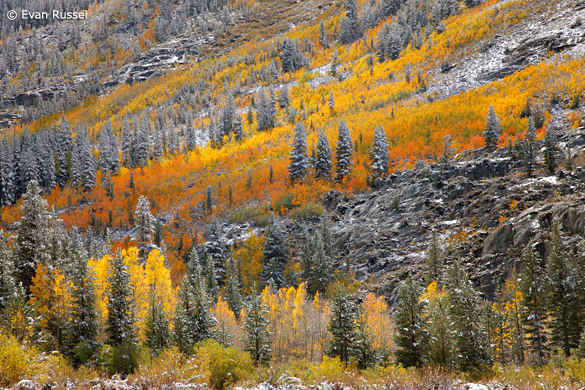
Aspens and snow in the Bishop Creek area, October 5th—Photograph by Evan Russel
After Tioga Pass closed last week I was stuck on the west side of the Sierra, but my friend Evan Russel, Ansel Adams Gallery staff photographer and one of my workshop assistants, made it over there a day earlier, and captured some some great images of snowy aspens after the storm on October 3rd and 4th. Here are a couple of examples. You can see more of Evan’s work on the Gallery’s Facebook page.
Meanwhile in Yosemite Valley autumn is progressing slowly. After some color suddenly appeared last week I thought that the leaves might turn quickly, but apparently the warm weather has slowed things down. I spent the last two days in the valley, and saw some trees that have partially changed, but none fully clothed in their fall colors. Claudia checked out the dogwoods along Highway 120 between the entrance station and Crane Flat and saw mostly green leaves, so it seems that even the higher-elevation trees haven’t changed yet.
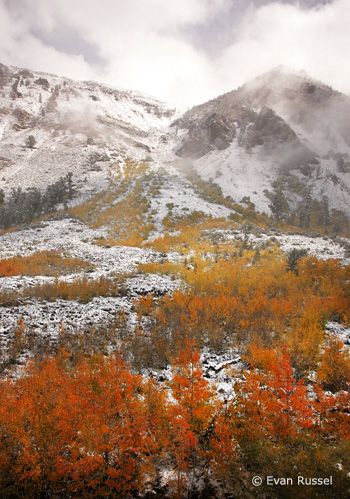
Aspens and snow in the Bishop Creek area, October 5th—Photograph by Evan Russel
While we may have to wait a bit for more color in the valley, this could also mean that all the deciduous trees will change at the same time. Usually the dogwoods and big-leaf maples turn earlier than the oaks and cottonwoods, and the color is spread out over several weeks. But occasionally all the trees turn together, creating some exceptional conditions.
On the eastern side of the mountains the color is not yet at its peak in the middle and lower elevations, but things are starting to change quickly, and color can be found in many of the medium-to-high-elevation aspen groves. I described some of the progress in my last two posts, but will add that on Tuesday I found some nice orange trees in the upper reaches of Lee Vining Canyon, along Highway 120. These aspens had shown very little color only three days earlier. The next two weeks could be great in places like Lundy Canyon, Lee Vining Canyon, June Lake Loop, and Conway Summit.


